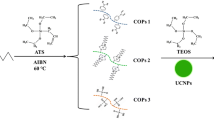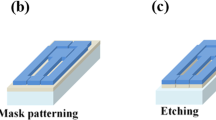Abstract
To address the need for facile, rapid detection of pathogens in water supplies, a fluorescent sensing array platform based on antibiotic-stabilized metal nanoclusters was developed for the multiplex detection of pathogens. Using five common antibiotics, eight different nanoclusters (NCs) were synthesized including ampicillin stabilized copper NCs, cefepime stabilized gold and copper NCs, kanamycin stabilized gold and copper NCs, lysozyme stabilized gold NCs, and vancomycin stabilized gold/silver and copper NCs. Based on the different interaction of each NC with the bacteria strains, unique patterns were generated. Various machine learning algorithms were employed for pattern discernment, among which the artificial neural networks proved to have the highest performance, with an accuracy of 100%. The developed prediction model performed well on an independent test dataset and on real samples gathered from drinking water, tap water and the Anzali Lagoon water, with prediction accuracy of 96.88% and 95.14%, respectively. This work demonstrates how generic antibiotics can be implemented for NC synthesis and used as recognition elements for pathogen detection. Furthermore, it displays how merging machine learning techniques can elevate sensitivity of analytical devices.
Graphical Abstract




Similar content being viewed by others
Data availability
All data generated or analyzed during this study are included in this article and its supplementary information files.
References
Canciu A, Tertis M, Hosu O et al (2021) Modern analytical techniques for detection of bacteria in surface and wastewaters. Sustainability 13:7229. https://doi.org/10.3390/SU13137229
Ramírez-Castillo FY, Loera-Muro A, Jacques M et al (2015) Waterborne pathogens: detection methods and challenges. Pathogens 4:307–334. https://doi.org/10.3390/PATHOGENS4020307
Li T, Zhu X, Hai X et al (2023) Recent progress in sensor arrays: from construction principles of sensing elements to applications. ACS Sens 8:994–1016. https://doi.org/10.1021/ACSSENSORS.2C02596/ASSET/IMAGES/MEDIUM/SE2C02596_0009.GIF
Geng Y, Peveler WJ, Rotello VM (2019) Array-based “chemical nose” sensing in diagnostics and drug discovery. Angew Chem, Int Ed 58:5190–5200. https://doi.org/10.1002/ANIE.201809607
Li Z, Askim JR, Suslick KS (2019) The optoelectronic nose: colorimetric and fluorometric sensor arrays. Chem Rev 119:231–292. https://doi.org/10.1021/ACS.CHEMREV.8B00226/ASSET/IMAGES/MEDIUM/CR-2018-00226F_0076.GIF
Mousavizadegan M, Alaei A, Hosseini M (2022) Optical detection of targets for food quality assessment. Nanosensing and bioanalytical technologies in food quality control. Springer, Singapore Singapore, pp 109–128
Zhang L, Wang E (2014) Metal nanoclusters: new fluorescent probes for sensors and bioimaging. Nano Today 9:132–157. https://doi.org/10.1016/J.NANTOD.2014.02.010
Mousavizadegan M, Hosseini M, Sheikholeslami MN et al (2023) Smartphone image analysis-based fluorescence detection of tetracycline using machine learning. Food Chem 403:134364. https://doi.org/10.1016/J.FOODCHEM.2022.134364
Zhang C, Liang M, Shao C et al (2023) Visual detection and sensing of mercury ions and glutathione using fluorescent copper nanoclusters. ACS Appl Bio Mater 6:1283–1293. https://doi.org/10.1021/ACSABM.3C00031/SUPPL_FILE/MT3C00031_SI_001.PDF
Bazzi F, Ebrahimi-Hoseinzadeh B, Sangachin EA, Hosseini M (2023) The integration of hybridization chain reaction (HCR) with fluorogenic silver nanoclusters (AgNCs) in an aggregation induced emission (AIE)-based nanosensor for sex determination and its forensic application. Microchem J 185:108188. https://doi.org/10.1016/J.MICROC.2022.108188
Xu J, Chen X, Zhou H et al (2024) Machine learning-assisted photoluminescent sensor array based on gold nanoclusters for the discrimination of antibiotics with test paper. Talanta 266:125122. https://doi.org/10.1016/j.talanta.2023.125122
Noreldeen HAA, Huang K-Y, Wu G-W et al (2022) Deep learning-based sensor array: 3D fluorescence spectra of gold nanoclusters for qualitative and quantitative analysis of vitamin B6 derivatives. Anal Chem 94:9287–9296. https://doi.org/10.1021/acs.analchem.2c00655
Xu J, Zhou H, Zhang Y et al (2022) Copper nanoclusters-based fluorescent sensor array to identify metal ions and dissolved organic matter. J Hazard Mater 428:128158. https://doi.org/10.1016/j.jhazmat.2021.128158
Sheini A (2021) A point-of-care testing sensor based on fluorescent nanoclusters for rapid detection of septicemia in children. Sens Actuators B Chem 328:129029. https://doi.org/10.1016/j.snb.2020.129029
Biancolillo A, Marini F (2018) Chemometric methods for spectroscopy-based pharmaceutical analysis. Front Chem 6:412780. https://doi.org/10.3389/FCHEM.2018.00576/BIBTEX
Mousavizadegan M, Firoozbakhtian A, Hosseini M, Ju H (2023) Machine learning in analytical chemistry: from synthesis of nanostructures to their applications in luminescence sensing. TrAC Trends Anal Chem 167:117216. https://doi.org/10.1016/j.trac.2023.117216
Behera B, Kumaravelan G, Kumar P (2019) Performance evaluation of deep learning algorithms in biomedical document classification. Proceedings of the 11th international conference on advanced computing, ICoAC 2019, p 220–224. https://doi.org/10.1109/ICOAC48765.2019.246843
Grandini M, Bagli E, Visani G (2020) Metrics for multi-class classification: an overview. arXiv preprint arXiv:2008.05756. https://doi.org/10.48550/arXiv.2008.05756
Chen G, Yang G, Wang Y et al (2021) Antibiotic-based magnetic nanoprobes combined with mPCR for simultaneous detection of Staphylococcus aureus and Bacillus cereus. Food Anal Methods 14:1964–1976. https://doi.org/10.1007/s12161-021-02026-z
Zeng Y, Wan Y, Zhang D (2016) Lysozyme as sensitive reporter for fluorometric and PCR based detection of E. coli and S. aureus using magnetic microbeads. Microchim Acta 183:741–748. https://doi.org/10.1007/s00604-015-1715-1
Bai X, Wang Z, Li W et al (2022) Rapid and accurate detection for Listeria monocytogenes in milk using ampicillin-mediated magnetic separation coupled with quantitative real-time PCR. Microchem J 183:108063. https://doi.org/10.1016/j.microc.2022.108063
Xiao F, Wang Z, Li W et al (2023) Cefepime-modified magnetic nanoparticles and enzymatic colorimetry for the detection of Listeria monocytogenes in lettuces. Food Chem 409:135296. https://doi.org/10.1016/j.foodchem.2022.135296
Sharma S, Singh G, Sharma M (2021) A comprehensive review and analysis of supervised-learning and soft computing techniques for stress diagnosis in humans. Comput Biol Med 134:104450. https://doi.org/10.1016/J.COMPBIOMED.2021.104450
Yahav D, Paul M, Fraser A et al (2007) Efficacy and safety of cefepime: a systematic review and meta-analysis. Lancet Infect Dis 7:338–348. https://doi.org/10.1016/S1473-3099(07)70109-3
Payne JN, Waghwani HK, Connor MG, et al (2016) Novel synthesis of kanamycin conjugated gold nanoparticles with potent antibacterial activity. Front Microbiol 7. https://doi.org/10.3389/fmicb.2016.00607
John T, Thomas T, Abel B et al (2017) How kanamycin A interacts with bacterial and mammalian mimetic membranes Biochim Biophys Acta (BBA) - Biomembr 1859 2242–2252. https://doi.org/10.1016/j.bbamem.2017.08.016
Zhang H, Fu G, Zhang D (2014) Cloning, characterization, and production of a novel lysozyme by different expression hosts. J Microbiol Biotechnol 24:1405–1412. https://doi.org/10.4014/jmb.1404.04039
Gardete S, Tomasz A (2014) Mechanisms of vancomycin resistance in Staphylococcus aureus. J Clin Invest 124:2836–2840. https://doi.org/10.1172/JCI68834
Zheng Y, Liu W, Chen Y et al (2019) Conjugating gold nanoclusters and antimicrobial peptides: from aggregation-induced emission to antibacterial synergy. J Colloid Interface Sci 546:1–10. https://doi.org/10.1016/j.jcis.2019.03.052
Bagheri Pebdeni A, Mousavizadegan M, Hosseini M (2021) Sensitive detection of S. aureus using aptamer- and vancomycin-copper nanoclusters as dual recognition strategy. Food Chem 361:130137 https://doi.org/10.1016/j.foodchem.2021.130137
Zheng Y, Wang X, Jiang H (2018) Label-free detection of Acinetobacter baumannii through the induced fluorescence quenching of thiolated AuAg nanoclusters. Sens Actuators B Chem 277:388–393. https://doi.org/10.1016/j.snb.2018.09.028
Qiu S, Lin Z, Zhou Y et al (2015) Highly selective colorimetric bacteria sensing based on protein-capped nanoparticles. Analyst 140:1149–1154. https://doi.org/10.1039/C4AN02106A
Kim H, Lee S, Min JS et al (2021) Fluorescent sensor array for high-precision pH classification with machine learning-supported mobile devices. Dyes Pigm 193:109492. https://doi.org/10.1016/j.dyepig.2021.109492
Hashem S, Keller PE, Kouzes RT, Kangas LJ (1995) Neural-network-based data analysis for chemical sensor arrays. In: Rogers SK, Ruck DW (eds). pp 33–40. https://doi.org/10.1117/12.205155
Ahmad MW, Mourshed M, Rezgui Y (2017) Trees vs neurons: comparison between random forest and ANN for high-resolution prediction of building energy consumption. Energy Build 147:77–89. https://doi.org/10.1016/j.enbuild.2017.04.038
Acknowledgements
The research leading to these results has received funding from Council of University of Tehran.
Funding
This study was funded by the Council of University of Tehran.
Author information
Authors and Affiliations
Contributions
Maryam Mousavizadegan: conceptualization, methodology, designing the analysis, visualization, data curation, ML model development, writing—original draft, review and editing. Mahsa Naghavi Sheikholeslami: data curation, ML model development, writing—review and editing. Morteza Hosseini: conceptualization, methodology, project administration and supervision, funding acquisition. Mohammad Reza Ganjali: writing—review and editing, project advisor. All authors have given approval to the final version of the manuscript.
Corresponding author
Ethics declarations
Ethical approval
This research did not involve human or animal samples.
Conflict of interest
The authors declare no competing interests.
Additional information
Publisher's Note
Springer Nature remains neutral with regard to jurisdictional claims in published maps and institutional affiliations.
Supplementary Information
Below is the link to the electronic supplementary material.
Rights and permissions
Springer Nature or its licensor (e.g. a society or other partner) holds exclusive rights to this article under a publishing agreement with the author(s) or other rightsholder(s); author self-archiving of the accepted manuscript version of this article is solely governed by the terms of such publishing agreement and applicable law.
About this article
Cite this article
Mousavizadegan, M., Hosseini, M., Sheikholeslami, M.N. et al. A fluorescent sensor array based on antibiotic-stabilized metal nanoclusters for the multiplex detection of bacteria. Microchim Acta 191, 293 (2024). https://doi.org/10.1007/s00604-024-06374-5
Received:
Accepted:
Published:
DOI: https://doi.org/10.1007/s00604-024-06374-5




